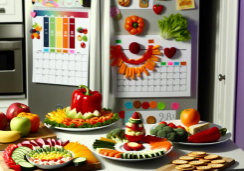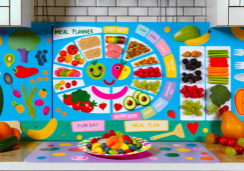Conquer Diabetes With Smart Meal Planning Strategies
As you stand at the crossroads of dietary choices, remember that the path to conquering diabetes is paved with smart meal planning strategies. You've likely heard that what you eat has a profound impact on your blood sugar levels, but the sheer abundance of dietary advice can be overwhelming.
It's time to simplify the process. You can take control of your health by learning how to balance macronutrients, understand carbohydrate counting, and time your meals to maintain optimal blood sugar control. With these tools in your arsenal, you'll be able to make informed decisions that support your diabetic management goals.
And while the journey to a balanced plate might seem daunting, knowing the right combination of foods to eat at each meal can transform this challenge into a manageable routine. Stick with me, and I'll show you how small, consistent changes in your eating habits can lead to significant victories in your health.
Understanding Carbohydrate Counting
Mastering the art of carbohydrate counting is a crucial step in controlling your diabetes, as it helps you monitor and manage your blood sugar levels with precision. You'll need to become adept at measuring and tallying the carbs in your meals and snacks. This isn't just about the amount of carbs, but also understanding how different types of carbohydrates—a slice of white bread versus a cup of quinoa, for instance—affect your blood glucose levels.
Familiarize yourself with food labels and portion sizes to make informed carb choices at meal times. The glycemic index of foods is also a handy tool, as it indicates how quickly a food will raise your blood sugar. By choosing foods with a lower glycemic index, you can maintain steadier blood glucose levels.
Healthy eating for diabetes isn't just about counting carbs, though. It's about making every Diabetes Meal count. This means incorporating a variety of foods in appropriate portion sizes, to ensure a balanced intake of nutrients.
For personalized Eating Tips, consider consulting with a registered dietitian. They can help you develop a Diabetes Meal plan that fits your lifestyle and preferences, making carb counting and healthy eating a more manageable part of your daily routine.
Balancing Macronutrients Effectively
To effectively manage your diabetes, it's essential to balance your intake of carbohydrates, proteins, and fats within your meals. A well-considered Diabetes Diet is more than just about cutting down sugar; it's about balancing macronutrients to maintain healthy blood sugar levels.
When you're planning your meals, keep in mind the following:
- Carbohydrates: Choose fiber-rich carbs like whole grains, which have a lower impact on blood sugar spikes. Incorporating them moderately in your meal plan can keep you fuller for longer and provide essential nutrients.
- Proteins: Include a source of protein in most meals to slow carbohydrate digestion. This helps stabilize your blood sugar levels and can be a key part of your diabetes management.
- Fats: Don't shy away from healthy fats; they're vital for satiety and overall health. However, be mindful of portions as fats are calorie-dense.
A healthy meal for diabetes isn't just about the food on your plate; it's also about how those foods work together. By balancing macronutrients, you'll support blood sugar control and may find it easier to maintain physical activity and overall well-being.
For a tailored meal plan that meets your individual needs, consider consulting with a registered dietitian. They can offer meal planning strategies that harmonize with your diabetes management goals.
Timing Meals for Optimal Control
While balancing macronutrients is crucial for managing diabetes, the timing of your meals also plays a significant role in stabilizing blood sugar levels. Eating at consistent times each day is a cornerstone of a successful eating plan. By sticking to a schedule where you consume three meals daily, spaced about 4-5 hours apart, you can help keep your blood sugar levels steady.
Skipping meals can lead to extreme fluctuations in blood sugar, with both highs and lows that can be dangerous for your health. Conversely, regular meal times signal your body to expect energy at certain intervals, which can prevent these peaks and troughs. Including a balance of carbohydrates, proteins, and healthy fats in your meals throughout the day further aids in this regulation.
Moreover, by planning your meals and meal plans ahead of time, you're less likely to find yourself in a position where you're overly hungry and at risk of overeating. Keep healthy snacks on hand to bridge the gap between meals if necessary.
Incorporating Diabetes Superfoods
Incorporating diabetes superfoods into your diet, such as nutrient-rich berries and fatty fish, can significantly enhance blood sugar management and overall health. These healthful foods are pivotal in your battle against Type 2 diabetes and can help lower your blood sugar levels. When you're meal planning, it's crucial to include foods that not only reduce your risk of diabetes complications but also support weight loss and overall well-being.
Here's how you can add these superfoods to your diet:
- Berries: Toss a handful of blueberries or strawberries into your morning oatmeal or yogurt. These tiny powerhouses are brimming with antioxidants and fiber, aiding in blood sugar control.
- Fatty Fish: Grill or bake salmon or trout at least twice a week. Rich in omega-3 fatty acids, they contribute to heart health, which is especially important for people with diabetes.
- Leafy Greens: Incorporate spinach or kale into salads, smoothies, or as a side dish. Low in calories and high in vitamins, they're ideal for maintaining a balanced diet.
Managing Portions and Calories
Getting a handle on portion sizes and calorie content plays a key role in managing your diabetes effectively. Meal planning isn't just about choosing healthy food choices; it's about managing portions to control calories and maintain stable blood sugar levels. Oversized servings can lead to spikes in blood sugar and unwanted weight gain, making it harder to manage your condition.
You don't need to skip meals to lose weight or control diabetes; rather, focus on the quality and quantity of what you're eating. A dietitian can provide valuable guidance on how many calories you should consume and what portion sizes look like for different foods. Using measuring cups or visual cues like the size of your fist can help you determine appropriate amounts without feeling overwhelmed.
Be especially cautious with calorie-dense foods that can disrupt your blood sugar balance. Learn to assemble your plate with the right balance of carbohydrates, proteins, and fats. If you're aiming to lose weight, cutting down on portion sizes can be an effective strategy for losing weight without compromising nutritional intake.
Lastly, consider keeping a food diary or using smartphone apps to track your meals. These tools can make it easier to stick to your meal planning goals, ensuring you're managing portions and calories effectively for better diabetes control.
Frequently Asked Questions
What Is the Most Popular Meal Planning Approach Used by Diabetics?
You'll often use the Plate method, focusing on macronutrient balance, portion control, and nutrient timing to manage your diabetes. Meal composition, fiber focus, and blood sugar monitoring are crucial to your meal planning strategy.
What Are Some Dietary Strategies to Helping to Manage Diabetes?
You can manage diabetes with carbohydrate counting, focusing on the glycemic index, and ensuring fiber-rich meals. Practice portion control, balance macronutrients, use sugar substitutes, choose healthy fats, consume anti-inflammatory foods, and don't forget hydration's importance.
What Is the Best Eating Schedule for Diabetics?
You'll benefit from eating at regular intervals, monitoring blood sugar, and practicing portion control. Include snacks, stay hydrated, and adjust insulin as needed. Count carbs and consider the glycemic index for optimal nutrient timing.
What Smart Foods Are Good for Diabetics?
You'll benefit from foods with a low glycemic index, fiber-rich options, and lean proteins. Practice carb counting, choose healthy fats, and control portions. Opt for antioxidant sources, sugar alternatives, and prioritize hydration and smart snack choices.
Conclusion
You've got this! By counting carbs, balancing your macronutrients, and timing your meals, you're on track to manage your diabetes effectively.
Remember to include those superfoods and keep an eye on portions.
It's about making smart, informed choices that work for you.
Keep it up, and you'll not only conquer diabetes but also embrace a healthier lifestyle.
Stay consistent and watch how these strategic meal planning steps can transform your health journey.










